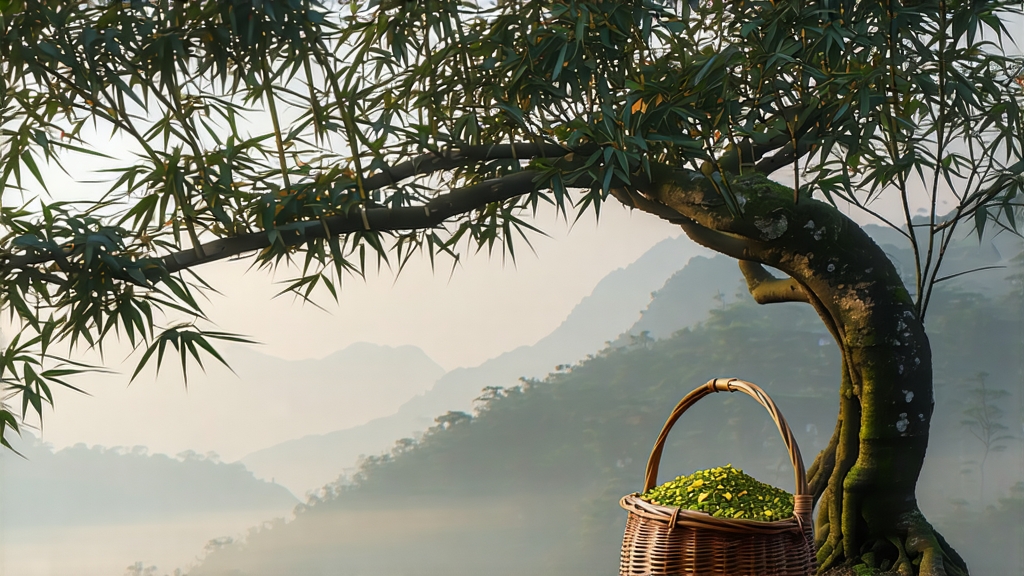
Tucked high above the Sichuan basin where warm valley vapors meet Himalayan winds, Meng Ding Huang Ya—literally “Yellow Bud from Meng Summit”—has been quietly perfecting its golden color and orchid-like aroma since the Tang dynasty. Foreign tea lovers often greet yellow tea as a mystery between green and oolong; Meng Ding Huang Ya is the most regal yet least exported of the clan, a leaf once reserved for emperors and now waiting to be rediscovered by the global palate.
1. A leaf born of poetry and politics
Meng Ding range, part of the western Qingling fold, rises to 1 456 m at Shangqing Peak. Cloud cover lingers 280 days a year, filtering sunlight into a soft, strobing glow ideal for slow amino-acid accumulation. Buddhist monk Wu Lizhen is said to have planted seven tea bushes on the summit in 53 BCE; by the Tang (618-907 CE) the leaves were taxed “in gold rather than coin,” and Song emperor Huizong declared Meng Ding the sole tea worthy of the state ancestral rites. When Ming Hongwu centralised tribute in 1391, yellow tea—its name still unofficial—was compressed into tiny golden cakes and escorted by mounted couriers to Beijing, a journey of 2 100 km that had to be completed before the Dragon-Boat Festival so that the new leaf could bless the imperial fleet. The Qing kept the tradition alive, but the 1911 revolution severed court demand; farmers either switched to green tea or let the mountain forests reclaim the gardens. Revival began in 1959 when a state work-team retraced the ancient footpaths, found 400-year-old seed-grown trees, and spent three years re-engineering the lost “men huang” (sealed yellowing) craft. Today only 120 ha of certified Meng Ding Huang Ya exist, producing barely 18 t per year—less than one day’s output of West Lake Dragon-Well.
2. One mountain, three micro-styles
Although all genuine Meng Ding Huang Ya comes from Yucheng District, Ya’an, the gardens are divided into three elevation bands, each yielding a stylistic variant:
- Summit Bud (Ding-ya): plucked at 1 300–1 456 m between Qingming and Grain Rain, consists of 100 % single buds, 1.2–1.5 cm long, downy and pale jade. After yellowing it becomes the colour of polished barley and infuses into a liquor so luminous it looks back-lit.
- One-leaf Bud (Xiao-ya): picked one week later, pairs the bud with the first unfolding leaf; the extra chlorophyll gives a greener baseline, but 48 h of sealed yellowing turns the vein network a warm parchment tone. It is the style most often seen in Chengdu tea houses because it withstands multiple steepings in a long-spout gaiwan.
- Two-leaf Bud (Lian-ya): harvested just before Summer Commences, includes the bud and two mature leaves. Farmers briefly oak-smoke it during the final drying, creating a faint whisky note that appeals to European black-tea drinkers curious about yellow tea.
All three styles share the same cultivar—Meng Ding Qunti, a seed-propagated landrace that keeps 43 % more theanine than the widely cloned Fuding Da-Bai—yet the elevation difference of only 200 m shifts the flavour from pure asparagus umami to honeyed apricot.
3. The craft: making green tea “turn back time”
The defining step is “sealed yellowing,” a controlled re-absorption of moisture that gently re-oxidises the leaf edges without microbial fermentation. After picking, the buds are spread 2 cm thick on bamboo trays and withered for 90 min in 22 °C mountain air to reduce moisture to 68 %. A 3-minute 160 °C drum kill-green locks in 85 % of the green character, but the leaf is still soft enough to bend like a pine needle. While conventional green tea would now be shaped and dried, Meng Ding Huang Ya is piled: 4 kg are wrapped in double-layered cotton cloth, then buried inside a 40 cm deep wooden coffer lined with fresh chestnut leaves that contribute a subtle vanillin. The coffer is slid into a 28 °C, 75 % RH cave chamber for 36–48 h. During this nap the leaf re-absor